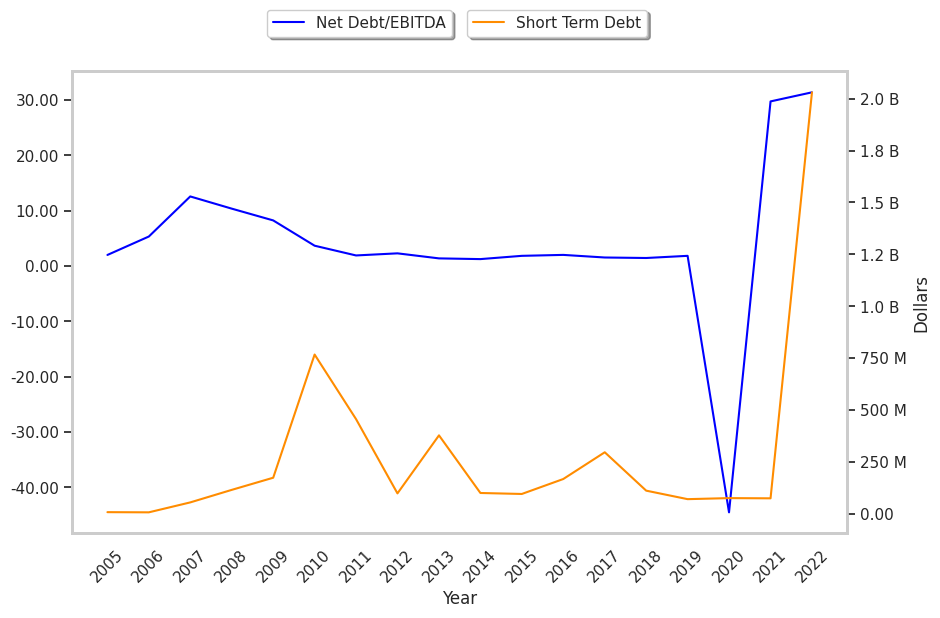Las Vegas Sands was one of the market's biggest losers today, losing 4.4% of its value and underperforming the S&P500 and Dow Industrial composite indices by 4.0% and 5.0% respectively. The large-cap Consumer Discretionary company ended the day at $45.55, closing in on its 52 week high low of $43.77 and is 31.59% below its average target price of $66.59. Over the last 12 months, Las Vegas Sands is down -3.0%, and has underperformed the S&P 500 by 16.0%. The stock has an average analyst rating of buy.
Las Vegas Sands has a trailing 12 month price to earnings (P/E) ratio of 52.4, which corresponds to its share price divided by its trailing earnings per share (EPS) of $0.87. The company's forward P/E ratio is 16.1 based on its forward EPS of $2.83.
Earnings refer to the net income of the company from its sales operations, and the P/E ratio tells us how much investors are willing to pay for each dollar of these earnings. By way of comparison, the Consumer Discretionary sector has historically had an average P/E ratio of 22.33. Whether the company's P/E ratio is within a high or low range tells us how investors are currently valuing the stock's earning potential, but it doesn't tell us how its price will move in the future.
Another metric for valuing a stock is its Price to Book (P/B) Ratio, which consists in its share price divided by its book value per share. The book value refers to the present value of the company if it sold all its tangible assets and paid off all debts today. Las Vegas Sands's P/B ratio of 7.64 indicates that the market may be overvaluing the company when compared to the average P/B ratio of the Consumer Discretionary sector, which is 3.12.
To understand Las Vegas Sands's business, and therefore its attractiveness as a potential investment, we must analyze its margins in two steps. First, we look at its gross margins, which take into account only the direct cost of providing the product or service to the customer. This enables us to determine whether the company benefits from an advantageous market position:
| Date Reported | Revenue ($ k) | Cost of Revenue ($ k) | Gross Margins (%) | YoY Growth (%) |
|---|---|---|---|---|
| 2023 | 8,574,000 | 7,137,000 | 17 | 189.47 |
| 2022 | 4,110,000 | 4,902,000 | -19 | -18.75 |
| 2021 | 4,234,000 | 4,923,000 | -16 | 65.96 |
| 2020 | 2,940,000 | 4,333,000 | -47 | -267.86 |
| 2019 | 12,127,000 | 8,762,000 | 28 | 3.7 |
| 2018 | 13,729,000 | 9,978,000 | 27 |
- Average gross margins: -1.7 %
- Average gross margins growth rate: -7.6 %
- Coefficient of variability (lower numbers indicate more stability): 10049.5 %
Next, we consider the Las Vegas Sands's operating margins, which take into account overhead. This tells us whether the company's business model is fundamentally profitable or not:
| Date Reported | Total Revenue ($ k) | Operating Expenses ($ k) | Operating Margins (%) | YoY Growth (%) |
|---|---|---|---|---|
| 2023 | 8,574,000 | 7,137,000 | 17 | 189.47 |
| 2022 | 4,110,000 | 4,902,000 | -19 | -18.75 |
| 2021 | 4,234,000 | 4,923,000 | -16 | 65.96 |
| 2020 | 2,940,000 | 4,333,000 | -47 | -256.67 |
| 2019 | 12,127,000 | 8,762,000 | 30 | 11.11 |
| 2018 | 13,729,000 | 9,978,000 | 27 |
- Average operating margins: -1.3 %
- Average operating margins growth rate: -7.6 %
- Coefficient of variability (lower numbers indicate more stability): 12242.9 %
From the above, we can see that Las Vegas Sands is not a profitable business. While unprofitable businesses may provide shareholders with attractive short term returns, more conservative investors will prefer to wait until the business can reach a profit before committing.
Our final point of analysis is Las Vegas Sands's free cash flow. While earnings and margins are calculated on the basis of a company's delivered goods, they do not actually represent physical payments that flow into the coffers. The actually money that the company has -- minus its capital expenditures -- is reported as its free cash flow, which for Las Vegas Sands is as follows:
| Date Reported | Cash Flow from Operations ($ k) | Capital expenditures ($ k) | Free Cash Flow ($ k) | YoY Growth (%) |
|---|---|---|---|---|
| 2023 | 2,117,000 | 839,000 | 1,278,000 | 180.13 |
| 2022 | -944,000 | 651,000 | -1,595,000 | -48.93 |
| 2021 | -243,000 | 828,000 | -1,071,000 | 57.82 |
| 2020 | -1,312,000 | 1,227,000 | -2,539,000 | -225.69 |
| 2019 | 3,038,000 | 1,018,000 | 2,020,000 | -46.16 |
| 2018 | 4,701,000 | 949,000 | 3,752,000 |
- Average free cash flow: $1.28 Billion
- Average free cash flow growth rate: -16.4 %
- Coefficient of variability (lower numbers indicating more stability): 1085.8%
This is the pool of liquidity that the company can use to reinvest in its business and to pay its equity investors a dividend. Investors in Las Vegas Sands enjoy a dividend yield of 0.8%, and they can expect this to continue based on the company's positive cash flows.
Las Vegas Sands does not meet the traditional definition of a fairly valued company. Unless the company has strong qualitative factors in its favor, most value investors will probably prefer to avoid this stock.



